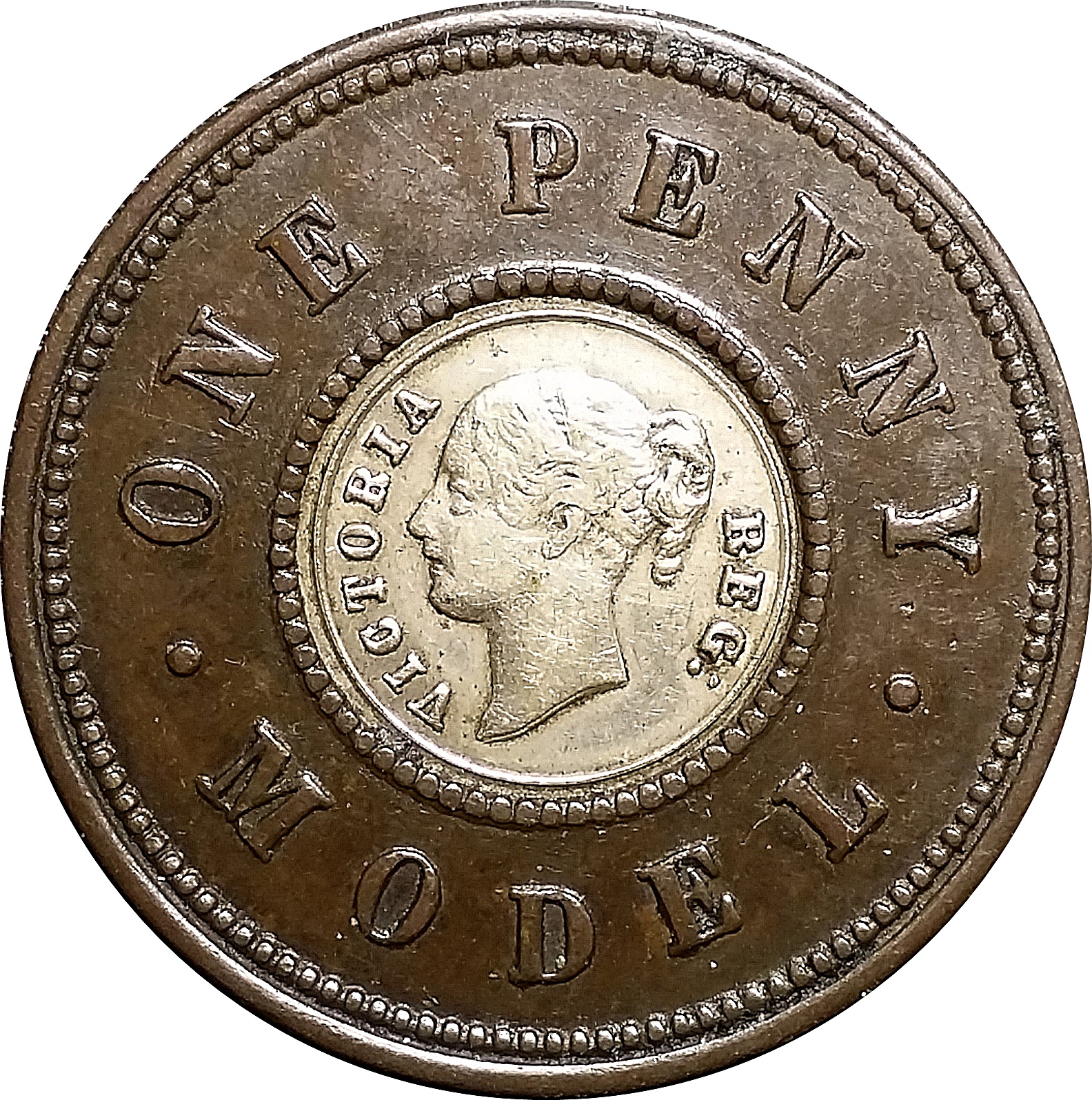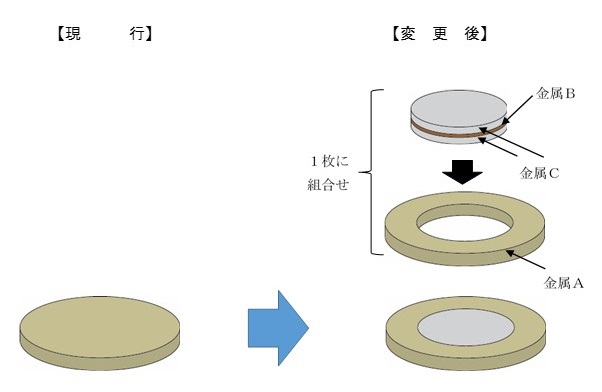|
1844 Victoria One Penny Model
The 1844 Victoria One Penny Model was a model coin issued by Birmingham medallist Joseph Moore (1817–1892) between 1844 and 1848, during a period in which the British Government were considering the notion of replacing the heavy copper coinage then in use. Their popularity with the public led to the Royal Mint to make a statement declaring that it was not responsible for their production. A feature that sets them apart from other coins of their age is that they were bimetallic. The outer part was made of copper, and the inner part was originally composed of silver to make up for the small intrinsic value of copper — but in most cases 60 percent zinc and 40 percent nickel were used. The design features an outer ring in which on the obverse and reverse the words 'ONE PENNY MODEL' are printed and an inner circle on the obverse of which a youthful portrait of Queen Victoria is shown with the words 'VICTORIA REG', and on the reverse is shown a numeral 1. [...More Info...] [...Related Items...] OR: [Wikipedia] [Google] [Baidu] |
Birmingham
Birmingham ( ) is a city and metropolitan borough in the metropolitan county of West Midlands in England. It is the second-largest city in the United Kingdom with a population of 1.145 million in the city proper, 2.92 million in the West Midlands metropolitan county, and approximately 4.3 million in the wider metropolitan area. It is the largest UK metropolitan area outside of London. Birmingham is known as the second city of the United Kingdom. Located in the West Midlands region of England, approximately from London, Birmingham is considered to be the social, cultural, financial and commercial centre of the Midlands. Distinctively, Birmingham only has small rivers flowing through it, mainly the River Tame and its tributaries River Rea and River Cole – one of the closest main rivers is the Severn, approximately west of the city centre. Historically a market town in Warwickshire in the medieval period, Birmingham grew during the 18th century during the Midla ... [...More Info...] [...Related Items...] OR: [Wikipedia] [Google] [Baidu] |
Joseph Moore (medallist)
Joseph Moore (17 February 1817 – 1901 or 1892) was a British medallist. Life and work Born in Birmingham, Joseph Moore was apprenticed at a young age to diesinker Thomas Halliday. He also trained under Samuel Lines, another diesinker and engraver. After completing his apprenticeship he began his own business in Birmingham with dies for button making, at the time one of the chief industries in Birmingham, and won a prize at the 1851 Great Exhibition in London for his work. While engaged in his apprenticeship and working as a buttonmaker, he studied in his own time to gain the skills of a medallist. He was a designer of medals principally, but first came to public attention when he created the 1844 Victoria One Penny Model. This penny was so popular with the public that William Wyon, coin die-sinker at the Royal Mint, felt 'compelled to advertise the fact that he pennieswere the result of private enterprise and not a government issue'. Later he entered the business of medallist ... [...More Info...] [...Related Items...] OR: [Wikipedia] [Google] [Baidu] |
Copper
Copper is a chemical element with the symbol Cu (from la, cuprum) and atomic number 29. It is a soft, malleable, and ductile metal with very high thermal and electrical conductivity. A freshly exposed surface of pure copper has a pinkish-orange color. Copper is used as a conductor of heat and electricity, as a building material, and as a constituent of various metal alloys, such as sterling silver used in jewelry, cupronickel used to make marine hardware and coins, and constantan used in strain gauges and thermocouples for temperature measurement. Copper is one of the few metals that can occur in nature in a directly usable metallic form ( native metals). This led to very early human use in several regions, from circa 8000 BC. Thousands of years later, it was the first metal to be smelted from sulfide ores, circa 5000 BC; the first metal to be cast into a shape in a mold, c. 4000 BC; and the first metal to be purposely alloyed with another metal, tin, to create ... [...More Info...] [...Related Items...] OR: [Wikipedia] [Google] [Baidu] |
Bimetallic Coins
Bi-metallic coins are coins consisting of two (''bi-'') metals or alloys, generally arranged with an outer ring around a contrasting center. Common circulating examples include the €1, €2, United Kingdom £1 and £2, Canadian $2, South Africa R5, Turkish 1 lira and 50 kurus, Indian ₹10 and ₹20, IDR 1K, 2 and 5 PLN, 50 CZK, 100 and 200 HUF, 1 and 2 BGN, Hong Kong $10, Argentine $1 and $2, Brazilian R$1, Chilean $100 and $500, Colombian $500 and $1000, and all Mexican coins of $1 or higher denomination. History Bi-metallic coins and medals have been issued for a long time. The Roman Empire issued special-occasion, large medallions with a center of bronze or copper and an outer ring of orichalcum, starting with the reign of Hadrian. Meanwhile, circulating bi-metallic coins are known from the 17th century. English farthings from 1684 through 1693 were made of tin with a central plug of copper for value. The silver-center cent pattern produced by the U ... [...More Info...] [...Related Items...] OR: [Wikipedia] [Google] [Baidu] |
Zinc
Zinc is a chemical element with the symbol Zn and atomic number 30. Zinc is a slightly brittle metal at room temperature and has a shiny-greyish appearance when oxidation is removed. It is the first element in group 12 (IIB) of the periodic table. In some respects, zinc is chemically similar to magnesium: both elements exhibit only one normal oxidation state (+2), and the Zn2+ and Mg2+ ions are of similar size.The elements are from different metal groups. See periodic table. Zinc is the 24th most abundant element in Earth's crust and has five stable isotopes. The most common zinc ore is sphalerite (zinc blende), a zinc sulfide mineral. The largest workable lodes are in Australia, Asia, and the United States. Zinc is refined by froth flotation of the ore, roasting, and final extraction using electricity ( electrowinning). Zinc is an essential trace element for humans, animals, plants and for microorganisms and is necessary for prenatal and postnatal development. It ... [...More Info...] [...Related Items...] OR: [Wikipedia] [Google] [Baidu] |
Nickel
Nickel is a chemical element with symbol Ni and atomic number 28. It is a silvery-white lustrous metal with a slight golden tinge. Nickel is a hard and ductile transition metal. Pure nickel is chemically reactive but large pieces are slow to react with air under standard conditions because a passivation layer of nickel oxide forms on the surface that prevents further corrosion. Even so, pure native nickel is found in Earth's crust only in tiny amounts, usually in ultramafic rocks, and in the interiors of larger nickel–iron meteorites that were not exposed to oxygen when outside Earth's atmosphere. Meteoric nickel is found in combination with iron, a reflection of the origin of those elements as major end products of supernova nucleosynthesis. An iron–nickel mixture is thought to compose Earth's outer and inner cores. Use of nickel (as natural meteoric nickel–iron alloy) has been traced as far back as 3500 BCE. Nickel was first isolated and classified as an e ... [...More Info...] [...Related Items...] OR: [Wikipedia] [Google] [Baidu] |
Queen Victoria
Victoria (Alexandrina Victoria; 24 May 1819 – 22 January 1901) was Queen of the United Kingdom of Great Britain and Ireland from 20 June 1837 until Death and state funeral of Queen Victoria, her death in 1901. Her reign of 63 years and 216 days was longer than that of List of monarchs in Britain by length of reign, any previous British monarch and is known as the Victorian era. It was a period of industrial, political, scientific, and military change within the United Kingdom, and was marked by a great expansion of the British Empire. In 1876, the British Parliament voted to grant her the additional title of Empress of India. Victoria was the daughter of Prince Edward, Duke of Kent and Strathearn (the fourth son of King George III), and Princess Victoria of Saxe-Coburg-Saalfeld. After the deaths of her father and grandfather in 1820, she was Kensington System, raised under close supervision by her mother and her comptroller, John Conroy. She inherited the throne aged 18 af ... [...More Info...] [...Related Items...] OR: [Wikipedia] [Google] [Baidu] |





